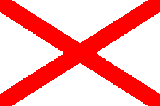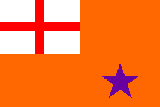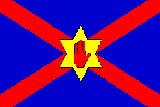Image |
Details
|
 |
Title: St. George's Cross
Description: The Cross of St. George, the Patron Saint of England, is the national English flag. This flag has been used to form the basis of a number of flags representing Northern Ireland (see below).
|
 |
Title: St. Andrew's Cross
Description: The national flag of Scotland was merged with the national flag of England in 1606 by King James I. It has grown very popular in Scotland given the increasing desire for devolution or independence. The flag is also found on Loyalist Murals suggesting the affinity between Ulster Protestants and Scots.
|
 |
Title: St. Patrick's Cross
Description: Even on St. Patrick's day, this flag is not widely flown by Irish people who, for the most part, do not recognise it as their own. It is seen as a British symbol, and is used by regiments of the British Army. [Additional note: The flag was first designed by British authorities in Dublin Castle in the 17th century as a counterpart to St. George's Cross. The flag also forms part of the coat of arms of the Duke of Leinster.]
|
 |
Title: British Union Flag
Description: This Union Flag is sometimes referred to as the 'Union Jack', although this name for the flag only correctly applies when the flag is flown on a ship. The flag is made up of the above three flags: St. George's Cross, St. Andrew's Cross, and St. Patrick's Cross. The design was meant to reflect the 1801 Act of Union between Britain (England, Wales, and Scotland) and Ireland (the Welsh flag was not incorporated into the Union Flag). The Union Flag is, by custom and practice rather than by any law, the official flag of the United Kingdom (UK), of which Northern Ireland is part. However, since 1973 there has been no official Northern Ireland flag. In the absence of such a flag, the Union Flag has been used and is an integral part of the Protestant, Unionist, and Loyalist tradition. |
 |
Title: Irish National Flag (Tricolour)
Description: Ireland's national flag has its origins in the French Revolution and the French flag. The Tricolour was designed to signify the peace (white) between Nationalists (green) and Unionists (orange). It was hoisted above the General Post Office in Dublin during the 1916 Easter Rising, and has since been used by Ireland's Nationalists and Republicans North and South of the border.
|
 |
Title: Province of Ulster Flag (nine counties)
Description: The Ulster Flag represents the nine counties of the ancient province of Ulster, and is one of the four provincial flags of Ireland. The flag is based on the crest of the O'Neill Chieftains of Ulster, who were renowned for their strong resistance to English rule, hence the flag is regarded as being Nationalist.
|
 |
Title: Leinster Flag/ Naval Jack
Description: This flag represents one of the four provinces of Ireland, Leinster, whose capital is Dublin. The flag was previously used by the United Irishmen in 1798, Daniel O'Connel's Repeal of the Union campaign in the 1830s and 1840s, and the Irish Republican Brotherhood (IRB). Contrary to popular belief, this flag was also used in the 1916 Rising, however the colour green was seen as exclusively Catholic, thus Sinn Fein favoured the Tricolour in 1918, as a flag embracing both Catholic and Protestant communities in Ireland.
|
 |
Title: The Four Provinces of Ireland
Description: This flag represents the four provinces of Ireland. Ulster is represented by the red and yellow nine counties flag. Munster is represented by three crowns on a blue background. Connaught has an eagle and an arm holding a knife, while Leinster is shown with a harp on a green background. The flag is almost exclusively used by Nationalists and Republicans.
|
 |
Title: Ulster Banner (or 'Government of Northern Ireland Flag', or 'Ulster Flag' - six counties)
Description: The Ulster Banner is based upon the St. George's Cross (see above) and has similarities to the Province of Ulster Flag (see above). In 1953 the ‘Ulster Banner’ was adopted as the flag of Northern Ireland by the Stormont administration. The adminstration was prorogued in 1972 and following the Northern Ireland Constitution Act 1973 this flag ceased to have any official standing. The flag remains in use by some sporting organisations. This particular flag of Northern Ireland is seen as staunchly Loyalist because of the Crown, the Star of David, and the Red Hand of Ulster. A number of other flags were based upon this design (see the alternative 'Ulster' flag below).
|
 |
Title: Alternative 'Ulster Flag' (six counties)
Description: This flag is very similar to the original Government of Northern Ireland flag except that it has no crown and has a British Union flag in the top left-hand corner. It is perceived as a Loyalist UDA flag, and the absence of the Crown suggests a more independent stance, due to a disillusionment with Britain and mainstream Unionism.
|
 |
Title: Orange Order Flag
Description: The Orange Order is an organisation with branches across Northern Ireland. It is exclusively Protestant and bans Catholics, and those married to Catholics, from joining. The flag is Orange with a purple star which was the symbol of the Williamite forces.
|
 |
Title: Orange Order Flag - Alternative Version
Description: This version of the flag is Orange with the English Cross of St. George in the top left hand corner and a purple star in the bottom right hand corner.
|
 |
Title: The Crimson Flag (or The defiant 'bloody flag' of the Apprentice Boys of Derry)
Description: The Apprentice Boys of Derry is a loyal order organisation that commemorates the siege of Derry in 1689. During the Williamite Wars, thirteen apprentice boys shut the gates of the city against the armies of the Catholic King James II, who was later defeated by the Protestant King William of Orange. The two dates commemorated by the Apprentice Boys of Derry are 18 December (when they shut the gates), and 12 August (the day the Siege was relieved by King William's forces). The crimson colour of the flag symbolises the bitter and 'bloody' struggle of the defenders.
|
 |
Title: Ulster Independence Flag (or Ulster National Flag)
Description: The flag was unveiled on 'Ulster Day', 17 November 1988, when the Ulster Independence Committee (now the Ulster Independence Movement; UIM) was formed. The flag is made up of St. Patrick's Cross and St. Andrew's Cross (see above), the six pointed star and the Red Hand of Ulster. The UIM claims to break from traditional Loyalist thought by promoting independence from both Ireland and Britain. The flag is also flown by members of other groups and is popular with some elements in the Ulster Defence Association (UDA).
|
 |
Title: Ulster Volunteer Force (UVF) Flag
Text: 'UVF'
Description: This flag can be seen on many Ulster Volunteer Force (UVF) murals. It has the Cross of St. George in the top left-hand corner.
|
 |
Title: The Starry Plough Flag
Description: The Starry plough illustrates the constellation of the same name (also known as the Big Dipper or the Great Bear) on a blue background. It was first used by the Irish Citizen's Army who were a socialist organisation which fought in the 1916 Easter Rising. The flag has also been used by a number of socialist and Republican paramilitary groups in Northern Ireland including the Workers' Party, the Irish Republican Socialist Party (IRSP), and the Irish National Liberation Army (INLA).
|
 |
Title: Sunburst (Fianna na hÉireann) Flag
Description: This flag represents the youth wing of the Irish Republican Army (IRA). Fianna na hÉireann literally means warriors of Ireland, taken from an ancient Celtic legend. The symbol of the sunburst can be seen on some Republican murals, highlighting the dawn of a new era.
|

















